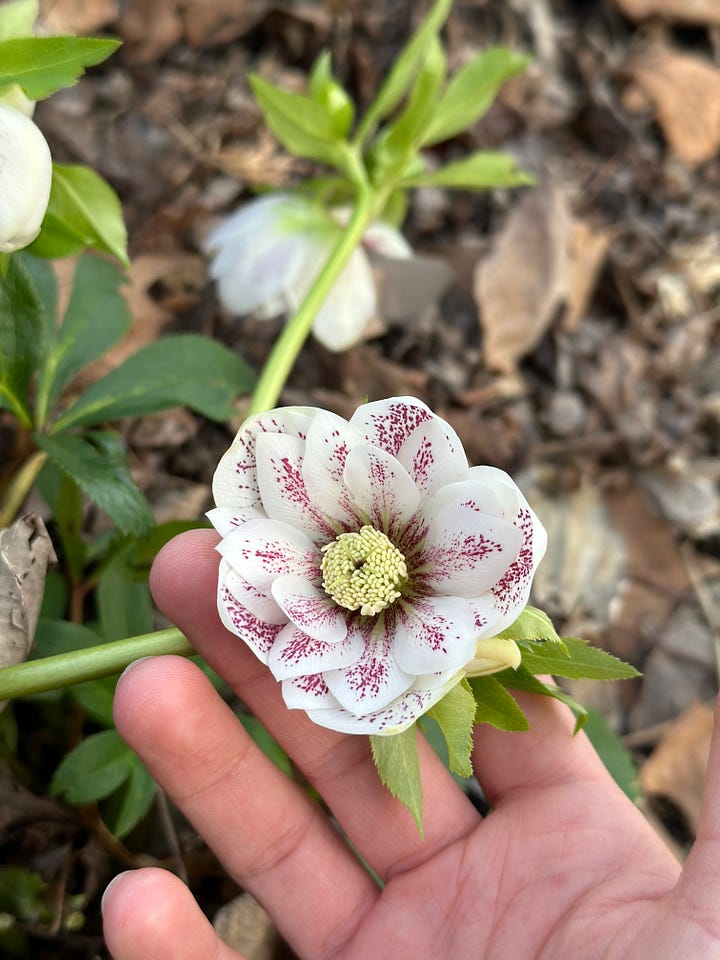
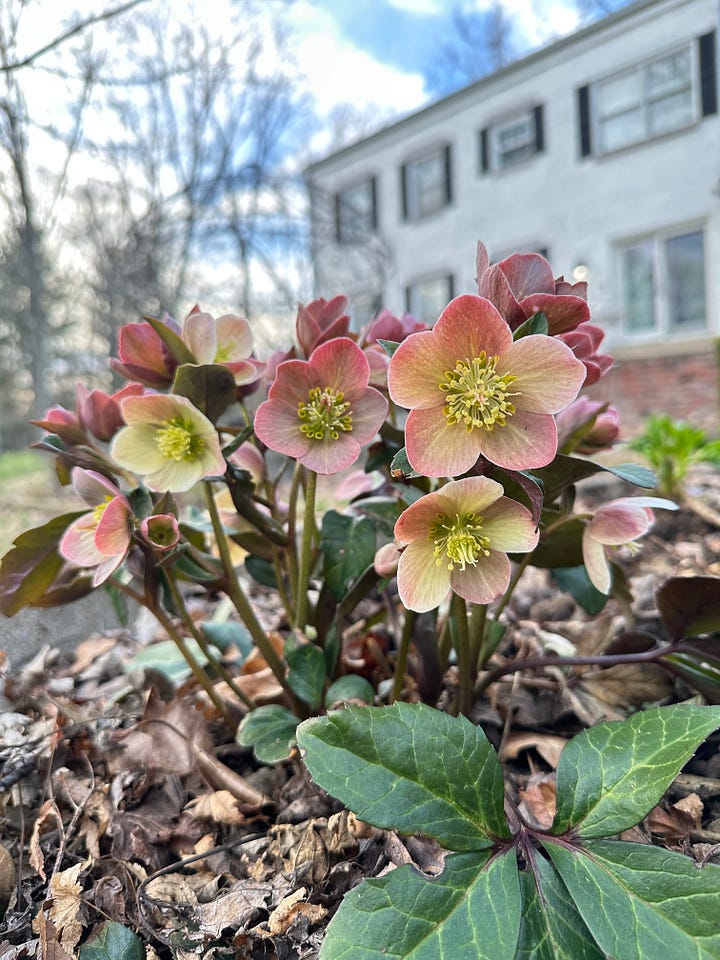
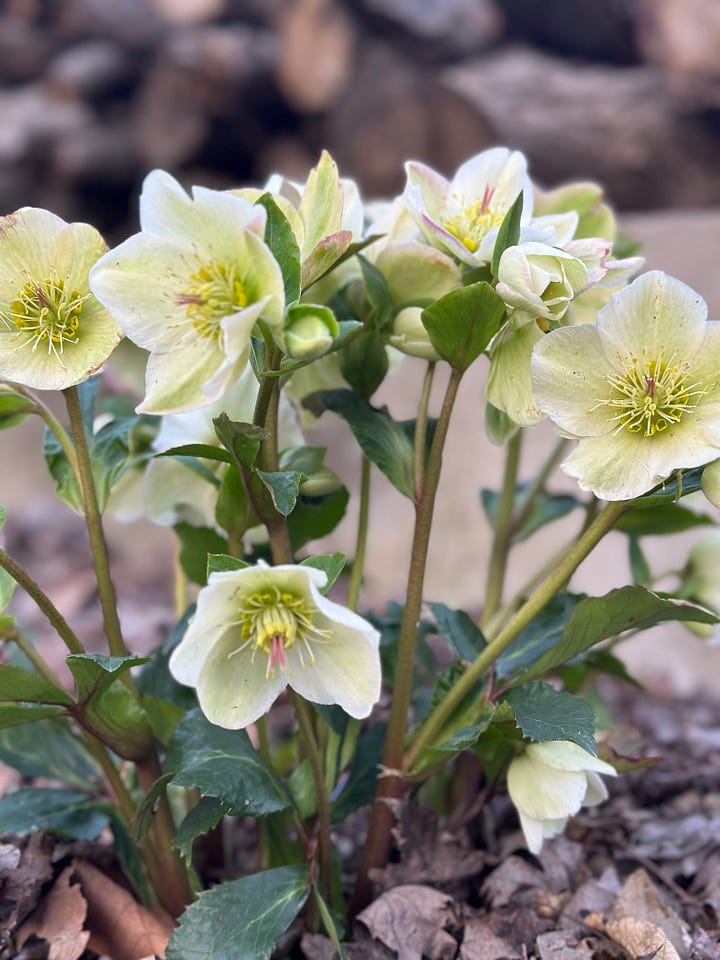
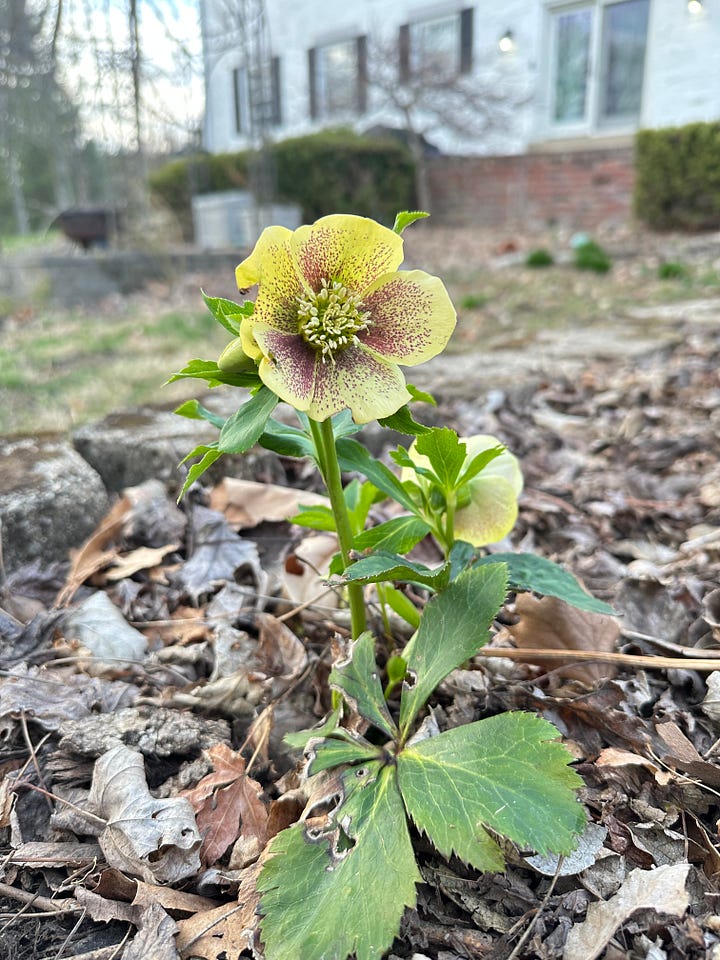
An Ode to Hellebore
I tell people I don’t have a favorite flower. As a florist and gardener, it’s so hard to choose favorites. I do have a couple flowers I gravitate towards during each season, but it’s been impossible to ever narrow it down further than that. Recently though, I heard myself talk. Specifically, I realized I talk about the flower hellebore more than I talk about any other.
I might even be a bit of a hellebore influencer. Any time someone asks me for advice for a shady area of their yard or garden, I cannot suggest “hellebore!” fast enough. They are readily available at local garden centers, but they can get a little pricey. Trader Joe’s usually carries hellebore flowers for a bit in late winter. If it’s a variety I don’t already have, I stock up. They have been available at Trader Joe’s recently. When I saw, I immediately texted a photo to three friends. “This will be the lowest price you ever see on this size of hellebore!”
Also, on two separate occasions, women have seen the hellebore in my Trader Joe’s cart and asked me about it. Lengthy garden conversation ensued, because I am an extrovert about garden topics. When I was finished shopping and entered the check out line, I saw my new garden friends again. They left the store with a hellebore under each arm. They had officially been influenced!
I was first introduced to hellebore via a florist social media account, years ago. I don’t remember who. At the time, we had no yard and most of our small landscape beds were in shade. I had such a hard time finding plants I loved that would thrive in shade. I had also began dabbling in floristry and was desperate to grow cut flowers of my own. Then, I discovered hellebore. They bloomed beautifully at the corner of our landscape bed, where they were shaded by our house and covered porch. They thrived in a tricky spot. I was immediately smitten!
Now, we have a yard with a lot of trees, so a large portion of my growing space is in shade. Hellebore grow really well at the base of deciduous trees, where they receive light in the spring but shade in the heat of summer. The collection of hellebore I have now is a mix of the plants from our last house and the hellebore I have accumulated since moving. A common phrase to describe the growth habit of perennial plants is “First they sleep, then they creep, then they leap!” Hellebore definitely follow this maxim. The first year you plant them, they seem like they are sleeping as they develop their underground root system. The second year, they show a little growth. The third year, they bloom prolifically.
Hellebore is also called the Lenten Rose. It blooms during the season of Lent, which we are in right now. Even before the first early, yellow daffodils raise their face to the sun, hellebore will be in bloom. Hellebore will even bloom through snow, which is incredibly beneficial in regard to the unpredictable springs in Ohio. Their leaves are semi-evergreen, so even after the flowers fade they still provide visual appeal in a garden area. Some varieties even have pink veining on their foliage, which is gorgeous.
They bloom in colors ranging from white, apricot, yellow, pink, maroon, green, metallic purple, and even black. They can be single or double flowered, meaning they can have one, two, even three rows of petals. My favorite series of hellebore (a series of plants is not an official way of classifying, but a way of marketing a group of cultivars by a plant breeder) is Wedding Party. Within the series are beautiful double hellebores with names such as “Maid of Honor,” “Honeymoon,” “Flower Girl,” “Whirlwind Romance,” and more. I am slowly collecting these varieties when I happen upon them. As a wedding florist, I do not need to explain why I am drawn to them.
Hellebore make finicky cut flowers, but with some tricks the rewards are outstanding. They need to be picked at the right stage, when seed pods have formed, in order to have any kind of vase life. A shallow slit can be made down the length of the stem with a knife to aid in hydration. This seems like a lot of work for a flower, but florists use a lot of nearly surgical tricks when designing. It’s always worth it. Hellebore are also expensive cut flowers, as all perennials are, when purchased wholesale for design work. This makes me love growing them myself even more!
As I mentioned, another name for the hellebore is the Lenten Rose, due to the timing of it’s blooms. When I am desperate for some color and my patience for winter has ended, there it is. It arrives as I am searching for signs of resurrection in nature and in my heart. What I admire when I look at a hellebore is not actually the petals. The colorful “bloom” of a hellebore is actually a bract or sepal. These flower parts are actually a type of leaf that act as a protective coverings for the petals. The petals are tubular and yellow, called nectaries. They surrounding the very center of the flower. The nectary petals are miniscule in comparison to the entire plant, but they hold the nectar that attracts pollinators. Pollination is necessary for seed production, for the multiplication of a plant. Hellebores remind me there is always a depth to beauty beyond what we quickly notice. That which multiplies beauty is worth protecting. We are covered and held by something greater than ourselves, the source of beauty.

Garden Update
We went on vacation last week and I thought of the garden constantly. I knew it would be time to hit the ground running as soon as we returned. When we left, nothing in the yard was in bloom. We came back to hellebore (which I just wrote about) and daffodils blooming. It felt like such a surprise, to leave the yard in a state of winter and come back to spring! We also came home to warmer weather than we left just the prior week. Ohio will do that…
I’ve had my first day of yard work for the year, which means my first day of bribing my children with one penny per stick so they help tidy the yard. Luckily, this year we have just the place for all those sticks- the raised beds. I’ve prepped the beds with a layer of cardboard to kill the grass and I’ve started filling them with sticks and other yard debris. A load of soil will arrive on Monday and then the hardest and most rewarding part will begin.
When temperatures are 65 degrees or warmer, it’s safe to take off greenhouse plastic covering from garden beds and give the plants some fresh air and sunshine. I have never overwintered any edible crop before, so I am very proud of the overwintered onions and carrots, shown below.
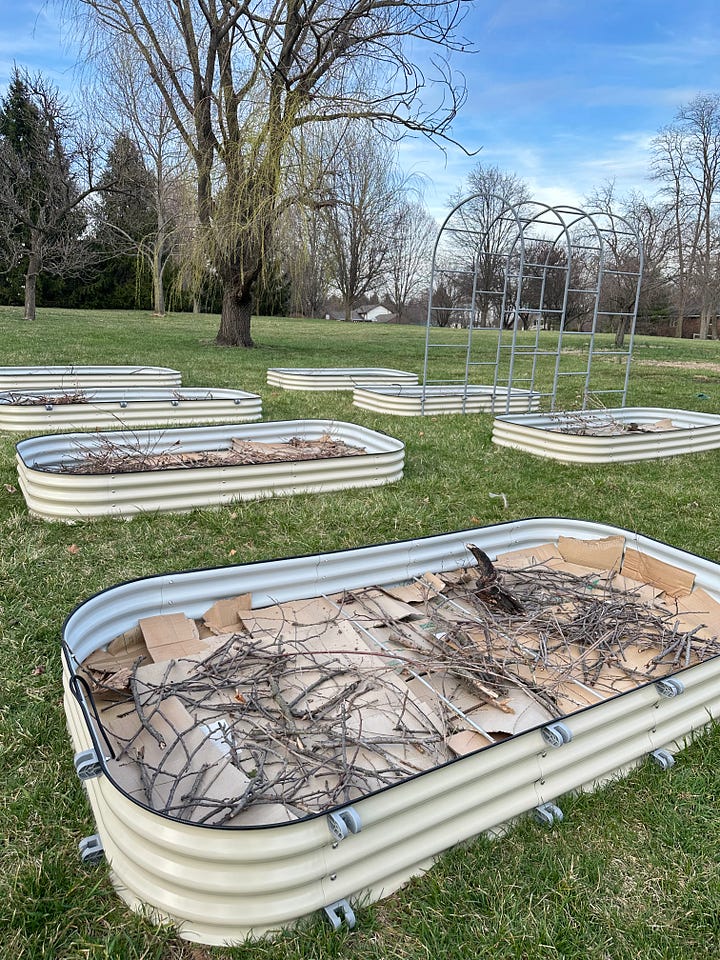
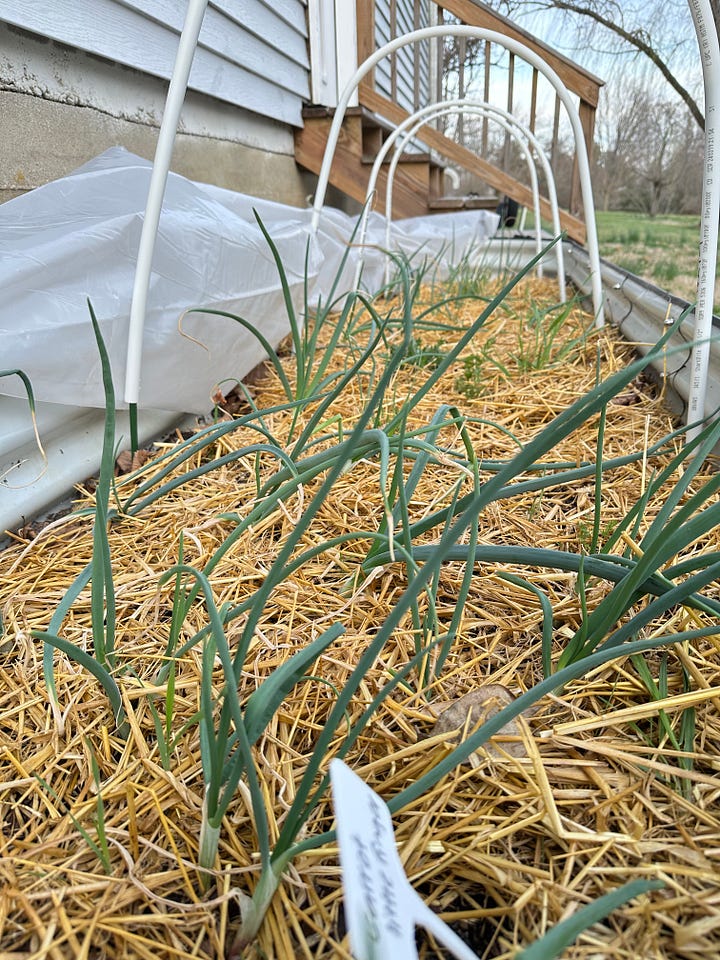
March is the month of seed starting! I had started seeds in the seed snails shown below right before we left for vacation. It was so rewarding to see that they had germinated and grown when I was away. I also had some seed casualties while away on vacation, but I knew that was a risk I was taking. This weekend I plan to have a big seed starting frenzy to accompany the class I am teaching on Saturday.
Every year I have to remind myself not to start things too early, that I’m not behind. I have to babysit each seedling I start until it’s time to plant them out. There’s still time and I’ll have much more started by the time the weekend is over.
I can’t wait to see those in attendance for the Seed Starting Workshop at Grandma’s Gardens this Saturday, March 22 at 11am. At the time I am writing this, there are only two more spots available. You can check availability and sign up HERE.
Seed starting is intimidating, but it doesn’t have to be! I can’t wait to give gardeners the confidence to start their own seeds. It’s so empowering!





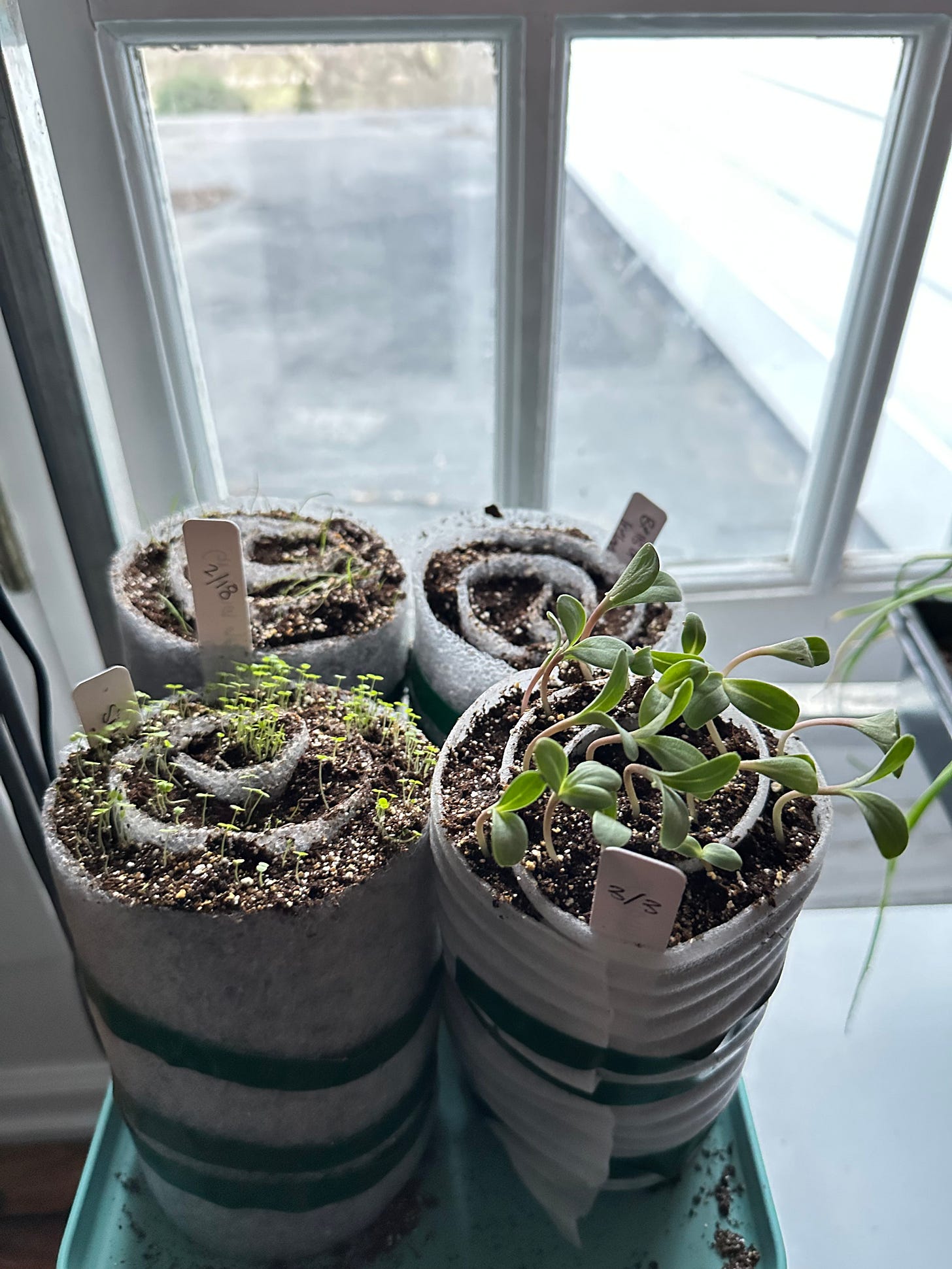
Here in Australia we don’t see a lot of hellebores. It’s really a shame as they’re stunning. As a florist I’ve used them in corsage and buttonholes and despite their delicate appearance they’re actually quite hardy. I’m in awe of you gardeners that work so consistently hard to grow your beautiful flowers!
Beautiful Kenton Rose